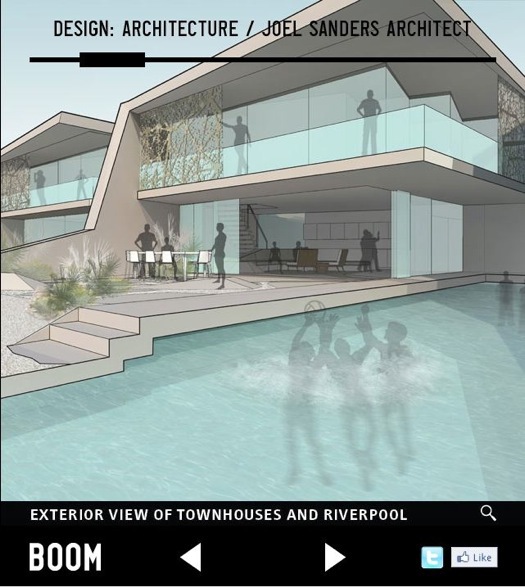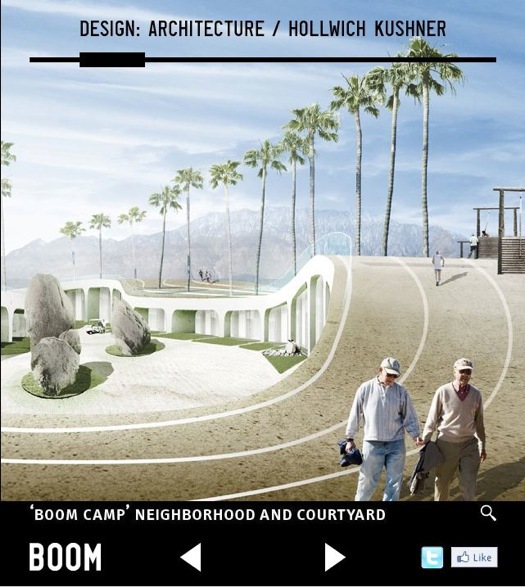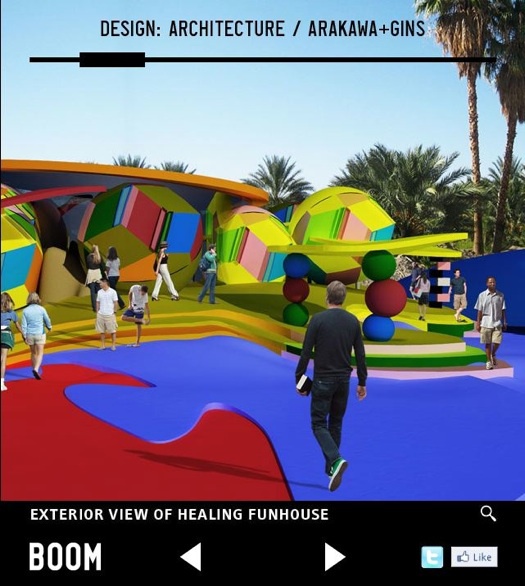
Page here and below from BOOM website, designed by Bruce Mau.
When New York architect Joel Sanders was first approached about being part of a design team for BOOM, a gay-friendly planned senior community outside of Palm Springs, California, he signed on at once. The concept, he says, dovetailed with his long-term interest in the intersection of architecture and gender. What’s more, he wanted to design a place for older residents in which people at different stages of health can commingle, unlike many nursing home and assisted-living situations today in which they are segregated. “It’s a radical idea, to mix people and ages and wellness,” Sanders says.
That will be the challenge for the developers of BOOM, who are investing $250 million into a project that merges high design with new ideas about senior living and lifestyles, at least for the wealthier end of the swelling Baby Boom generation. With more than 300 residences designed by leading and emerging architects, BOOM aims to make aging more enjoyable with not only architecturally inventive residences but also with an entertainment complex, boutique hotel, wellness center and spa, all connected by pedestrian-friendly pathways and plazas and a meticulously landscaped desert environment.
Conceived at first for older gays but now expanded to a wider market, the developers believe that cutting edge design by Sanders, Diller Scofidio + Renfro, Jügen Mayer H and LOT-EK, among others, will create an atmosphere of energy and vitality and a community of kindred spirits. “There’s hardly any progressive architecture for retirees in American today,” says Matthias Hollwich, founding principal of Hollwich Kushner Architects, a New York firm that is the project leader. “There are 17,000 nursing homes in the country and 17,000 reasons not to live in any of them,” he adds. His firm’s design for one of BOOM's mini-neighborhoods is a doughnut-shaped condo building with a running track on the roof and a canyon in the center for group get-togethers.

BOOM certainly represents a departure from the usual drab institutionalized look of most senior residences, and even the newer generation of more thoughtfully designed assisted-living facilities and active-adult communities. Consider, for example, Diller and Scofidio’s housing units with pre-cast concrete roofs that look like waves, or LOT-EK's loft-style residences, which resemble stacked, slanted boxes. Israeli firm L2 Tsionov-Vitkon envisioned homes in the form of sculpted rocks, while Slovenia’s Sadar + Vuga’s design is inspired by flower petals. All the buildings “promote both privacy and social interaction,” according to BOOM’s website, which was designed by Bruce Mau. There are also plans for a children’s playground and a commercial complex with a rooftop disco bar and shops as well as a bocce ball court. And of course, Palm Springs is nearby.
The concept is based on so-called affinity retirement communities, but in this case with a focus on gays who, developers realized, would not go for “the typical desert golf complex.” Instead, they “would be determined to live only in a community whose design was in sync with a sophisticated, active lifestyle,” the BOOM website points out. At first, the goal was to attract LGBT people over age 65 because research suggested that many gays go back into the closet at that age due to fear of discrimination in nursing homes. This target age minimum was scaled back to 55 and then to 40 because, as Hollwich puts it, “there is a break in lifestyle at 40 from going out and partying to looking for something more meaningful.”

Hollwich says that the architects were told to “just imagine yourself in a couple of years from now and think about what you would want to experience. Design for yourself, not an aging community and develop your own vision.” Residences range from studios to 4-bedroom units, with a total population of around 800. Sanders’s design includes housing units with different family structures in mind: he calls them “Golden Girls” (for roommates) and "The Birdcage" (for partners with kids). The houses have private linear lap pools that merge with a larger communal pool at the spa, reinforcing the idea of individual and public spaces, Sanders says.
Whether BOOM will attract buyers in sufficient numbers to make it economically viable is unclear. The move to market it as more inclusive – open to gays and straights and a wider range of ages, but keeping the gay-friendly motto – will certainly help, and forestall what might have become another ghetto. For his part, Sanders says he opposed making BOOM exclusively gay, believing instead that it should be of interest to anyone who is “design-oriented.” As Hollwich explains, “It is about a bold community that invites everyone to think differently about aging. All kinds of people will be going there.”

